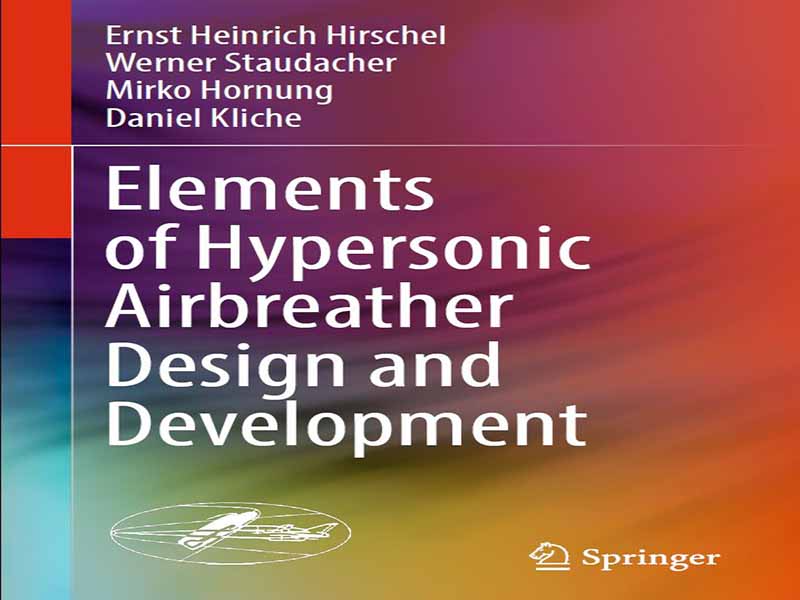- عنوان کتاب: Elements of Hypersonic Airbreather Design and Development
- نویسنده: Ernst Heinrich Hirschel
- حوزه: حرکت مافوق صوت
- سال انتشار: 2025
- تعداد صفحه: 329
- زبان اصلی: انگلیسی
- نوع فایل: pdf
- حجم فایل: 8.87 مگابایت
پرواز مافوق صوت با تنفس هوایی موضوع جذابی است. تلاشهای زیادی برای پیشبرد آن در جهت عملیات واقعی انجام شده است. جدا از کاربردهای نظامی که در اینجا مورد توجه قرار نمیگیرند، هیچ مطالعه یا پروژهای به اندازه کافی پیشرفت نکرده است. استثنائات قابل توجه، پروازهای X-43A و X-51A هستند که صرفاً وسایل نقلیه پروازی آزمایشی با اندازه نسبتاً کوچک بودند. دو دهه آخر قرن گذشته شاهد تعدادی مطالعه در مورد سیستمهای حمل و نقل فضایی تک مرحلهای به مدار (SSTO) و دو مرحلهای به مدار (TSTO) بوده است. پیشرانش با تنفس هوایی به شکل پیشرانش رمجت و اسکرمجت نقش تعیینکنندهای ایفا کرد. موضوع دیگری که جذابیت زیادی داشت، پرواز مسافربری مافوق صوت با تنفس هوایی در مسافتهای طولانی بود که مسافت پرواز آن تا نیمی از کره زمین متغیر بود. چنین مطالعاتی تا قرن حاضر ادامه یافته و ادامه دارد. فناوری پیشرانش همچنان مورد توجه ویژه بوده و هست. این مربوط به رمجت و به ویژه اسکرمجت و همچنین مفهوم موتور انفجاری است. تحقیقات پایه در مورد فناوری پیشرانش و همچنین در مورد – پس از یک غفلت تا حدی غیرقابل توضیح – موضوع تعیینکننده انتقال آرام-آشفته لایههای مرزی هایپرسونیک انجام شده و میشود. موضوع طراحی ساختار بدنه هواپیما با خاصیت ارتجاعی واقعی در مقابل الاستیک کامل نیز مورد توجه لازم قرار نگرفته است. این موضوع با توجه به بدنههای نسبتاً بزرگ هواپیماهای تنفس هوایی بالقوه هایپرسونیک و آزمایش زمینی لازم برای خواص الاستیک استاتیک و دینامیکی آنها، از اهمیت بسیار زیادی برخوردار است، که همه اینها با توجه به موضوع ادغام بدنه-پیشرانش است. پرواز امروزه در اعداد ماخ پروازی بالاتر از M5، هایپرسونیک در نظر گرفته میشود. حوزه پیشرانش رمجت امروزه در بازه 3 M7 دیده میشود و پس از آن حوزه پیشرانش اسکرمجت قرار دارد که تا M12 میرسد. به دلیل افزایش فشار دینامیکی با M، هر دو حوزه پرواز به معنای پرواز در ارتفاعات بسیار بالاتر از دامنه توربوجت هستند. بارهای حرارتی وارد بر وسیله نقلیه هوایی – که به شدت به وضعیت لایه مرزی، چه آرام و چه آشفته، بستگی دارند – با افزایش عدد ماخ پرواز به شدت افزایش مییابند. از این رو، آگاهی از مکان، شکل و وسعت ناحیه انتقال آرام-آشفته از اهمیت بالایی برخوردار است. با این حال، این مشکلی است که هنوز به میزان لازم مورد بررسی قرار نگرفته است. موضوع بارهای حرارتی از طریق آیروترموالاستیسیته ساختاری، به بدنه هواپیما و ادغام بدنه-پیشرانه نیز مربوط میشود. برای مورد دوم، شش نوع ادغام بدنه-پیشرانه (API-) در این کتاب تعریف شده است. همه آنها نقش تعیینکنندهای در صدور گواهینامه نهایی وسیله نقلیه هوایی نیز دارند. نوع API نیز نقش مهمی در قابلیت پرواز و کنترلپذیری هواپیمای هواتنفسی مورد بررسی دارد. در مجموع باید تأکید کرد که برای ایجاد مفهوم یک هواپیمای هایپرسونیک با قابلیت تنفس هوا یا یک رزمناو هایپرسونیک با قابلیت تنفس هوا در سراسر جهان کافی نیست. مباحث طراحی، توسعه، آزمایش زمینی، تأیید و در نهایت صدور گواهینامه قبل از شروع به کار، از اهمیت بالایی برخوردارند. از این رو، این کتاب به شرح مختصری از طراحی، توسعه و مسائل مهندسی مربوط به وسایل پرنده اختصاص داده شده است. این موضوع تا حدی ناقص است، در واقع حتی فاقد جزئیات مهم برخی از مراحل است. با توجه به چالشهای زیستمحیطی فوری، باید پرسید که آیا پرواز مافوق صوت با تنفس هوا – در سطح غیرنظامی – هنوز هم باید موضوعی ارزشمند باشد. حداقل سه پاسخ وجود دارد. (1) با سیستمهای TSTO که از LH2 به عنوان سوخت استفاده میکنند، میتوان اثرات زیستمحیطی پرتاب به مدار را در مقایسه با پرتاب موشک صرف کاهش داد. (2) دسترسی به فضا با یک سیستم TSTO از مکانهای دور در شمال، که منطق برنامه فناوری مافوق صوت آلمان در دهههای 1980/1990 بود، دلیل موجهی برای دنبال کردن پرواز مافوق صوت با تنفس هوا است. (3) پرواز مسافربری مافوق صوت با مسافت طولانی، که با این حال، با توجه به اثرات زیستمحیطی مذکور، مشکلساز به نظر میرسد. در طراحی و توسعه هواپیماهای تنفس هوای مافوق صوت، تعداد زیادی پدیده و مشکل وجود دارد که در طراحی هواپیماهای معمولی وجود ندارند. مشکلات خاصی در ابزارهای شبیهسازی موجود وجود دارد. طراح باید از پتانسیلها و کاستیهای ابزارها و امکانات محاسباتی و تجربی آگاه باشد. این امر عمدتاً به حوزههای آیروترمودینامیک، پیشرانش و مکانیک سازه مربوط میشود. از اوایل دهه 1980، زمانی که پرواز مافوق صوت تنفس هوای به موضوعی جالب تبدیل شد، محاسبات و بهینهسازی رشتهای و چند رشتهای پیشرفتهای شگفتانگیزی را ایجاد کرد. دومین “موج ریاضیسازی” اتفاق افتاد. این به دلیل پیشرفتهای عظیم در قدرت و ذخیرهسازی کامپیوتر و به همان اندازه به دلیل پیشرفت بسیار چشمگیر در زمینه الگوریتمهای عددی بود. شبیهسازی تجربی با تکنیکهای اندازهگیری اپتوالکترونیکی آن نیز به لطف قدرت و قابلیتهای ذخیرهسازی کامپیوتر شکوفا شد، که …
Airbreathing hypersonic flight is a fascinating topic. Many attempts have been made to advance it in the direction of actual operation. Apart from military applications, which are not considered here, no study or project advanced far enough. Notable exceptions are the flights of the X-43A and the X-51A, which were pure experimental flight vehicles of rather small size. The last two decades of the previous century have seen a number of studies of single-stage-to-orbit (SSTO) and two-stage-to-orbit (TSTO) space transportation systems. Airbreathing propulsion in form of ramjet and scramjet propulsion did play a deciding role. Another topic with much appeal was that of long-haul airbreathing hypersonic passenger flight, with flight distances ranging up to half around the globe. Such studies extended and continue into the present century. Of particular interest remained and still remains the propulsion technology. That regards the ramjet and in particular the scramjet, and also the detonation engine concept. Basic research was and is conducted on propulsion technology and also concerning—after a, to some extent inexplicable neglect—the all deciding topic of laminar-turbulent transition of hypersonic boundary layers. The topic of realelastic versus perfect-elastic airframe structure design technology, too, has not found the needed interest. It is of very large importance when considering the partly quite large airframes of potential hypersonic airbreathers and the necessary ground testing of their static and dynamic elastic properties, this all in view of the topic of airframe-propulsion integration. Flight nowadays is considered to be hypersonic at flight Mach numbers above M 5. The ramjet-propulsion domain today is seen in the interval 3 M 7, followed by the scramjet-propulsion domain, which reaches up to M 12. Because of the rising of dynamic pressure with M , both flight domains imply flight at altitudes much higher than those of the turbojet domain. Thermal loads on the flight vehicle—depending strongly on the state of the boundary layer, either laminar or turbulent—are rising extremely with rising flight Mach number. Hence knowledge of the location, the shape and the extent of the laminar-turbulent transition zone is of utmost importance. However, this is a problem, which still is not mastered to the necessary degree. The thermal loads topic via structural aerothermoelasticity also regards the airframe and the airframe-propulsion integration. For the latter, six airframepropulsion integration (API-) types are defined in this book. All plays a deciding role also in the final flight-vehicle certification. The API-type plays an important role also regarding flyability and controllability of the airbreather under consideration. All in all it must be emphasized that it is not sufficient to create the concept of an airbreathing hypersonic aircraft or that of a globe-spanning airbreathing hypersonic cruiser. The topics design, development, ground testing, verification and finally certification before commission into service begins, are of eminent importance. Hence this book is dedicated to a sketch of relevant flight vehicle design, development and engineering issues. That to a degree is incomplete, in fact even lacking important details of some phases. In view of the urging environmental challenges one has to ask whether—civil— airbreathing hypersonic flight should still be a worthwhile topic. There are at least three answers. (1) With TSTO-systems using LH2 as propellant it could be possible to reduce the environmental impact of launch to orbit in comparison to pure rocket launch. (2) The access to space with a TSTO-system from places far in the north, which was the rationale of the German Hypersonics Technology Programme in the 1980s/1990s, is a viable reason to pursue airbreathing hypersonic flight. (3) Longhaul hypersonic passenger flight, which however, appears to be problematic in view of the said environmental impact. Regarding the design and development of hypersonic airbreathers a large number of phenomena and problems is present, which are not existing in ordinary aircraft design. Particular problems exist with the available simulation means. The designer must be aware of the potentials and the shortcomings of both the computational and experimental tools and facilities. This mainly regards the fields of aerothermodynamics, propulsion and structural mechanics. Since the early 1980s, when airbreathing hypersonic flight became an interesting topic, disciplinary and multidisciplinary computation and optimization made marvelous developments. The second “mathematization wave” did happen. That was due to the enormous developments of computer power and storage and to the same degree due to the very impressive progress in the field of numerical algorithms. Experimental simulation with its opto-electronic measurement techniques also flourished thanks to the computer power and storage capabilities, which became available. Computational flow simulation allows to treat steady and unsteady flow fields past and through configurations of all kinds, including surface radiation cooling—which is the permitting factor of hypersonic flight from the structural side—and thermochemical phenomena. Movable surfaces as well as aerothermoelastic deformations can be handled, and in particular also heat-transfer phenomena, both by conduction and radiation.
این کتاب را میتوانید از لینک زیر بصورت رایگان دانلود کنید:
Download: Elements of Hypersonic Airbreather Design and Development



































نظرات کاربران